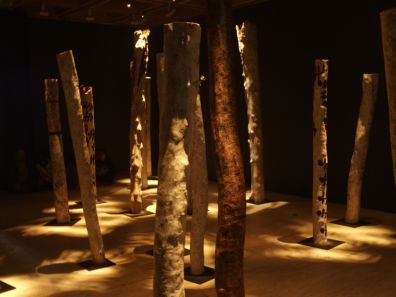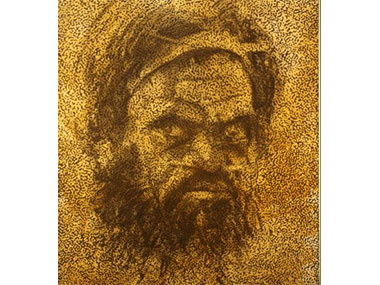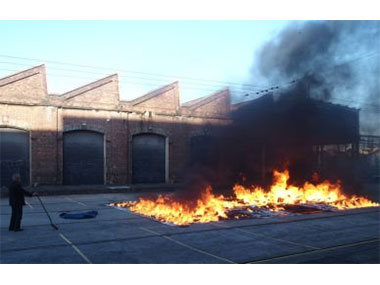A BIENNALE OF RINGGITJ

The dancing forest of larrikitj by Nayapanyapa Yunupingu in the 20th Biennale of Sydney (Photo: Jeremy Eccles)
Posted by Jeremy Eccles | 18.03.16
Dates:
18.03.16
: 05.06.16
Location: Sydney
So – you employ a German woman who runs a major London art institution (the Hayward Gallery, conveniently closed for restoration) to come up with an international Biennale in Sydney. As with all of the far-too-many Biennales and Biennials across the world, the Idea has to come first. It's usually so superficially meaningful that everyone ignores it and gets down to hating (or, occasionally, loving) the art.
In Stephanie Rosenthal's case, we have two Ideas – the wishy-washy, imported 'The future is already here – it's just not evenly distributed' – a patently and increasingly apparent truism that's actually a problem for Canberra and capitalism and is never going to be solved by artwork; and the locally revealed title for Rosenthal's organising principal – 'Embassies of Thought'.
Given the spread of art around four major venues – the AGNSW, the Museum of Contemporary Art, Carriageworks and Cockatoo Island - plus Artspace, the Mortuary Station beside Central and a number of one-off sites, the Director wanted to establish different themes for each place rather than lumping art upon art randomly. Whether her categories/Embassies achieve their intended identities, I'll leave you to judge. But it does have the benefit of concentrating the mind and diminishing the usual sense of utter confusion I've felt at most Biennales when leaving an overwrought place like Cockatoo Island.
So Cockatoo is the Embassy of the Real, AGNSW – of the Spirits, MCA – of Translation, and Carriageworks – of Disappearance.
But this fundamental idea of embassies arose not from the elegant world of wing-collared diplomats swigging champers but the more ancient Indigenous idea called Ringgitj in Yolngu. For, if you had a songline that extended well beyond your tribal territory – as most do – you'd need to travel that songline and visit its most scared sites at some stage in your life, much as Muslims need to go to Mecca. But to enter another tribe's territory, you'd need a passport; and while you performed your ceremonies at any significant sites, you'd need an embassy...a safe place to dance and hang out, protected by the locals.
It would seem that diplomacy in Australia may be a whole lot older than in Europe or Asia. But could it be that, having embraced the idea of Ringgitj, Stephanie Rosenthal also appreciated the essential Indigenous link between ceremony and art? For there's much performance in this Biennale, perhaps reflecting the West's return to the ancient roots of culture; everything from a full-blown opera reconstructed from its Russian Revolutionary origins via many forms of dance to four women sitting around and recalling performances they'd been struck by. I guess that's the post-Modern bit!
No performance was necessary though at the Art Gallery of NSW in a darkened space filled with theatrically lit larrikitj. You have to dance your way between this forest of decorated Yolngu bone coffins emanating from the unique mind of Nyapanyapa Yunupingu. The lady herself sat invisibly in a corner watching our terpsichorean responses. For me it was probably the closest I've ever got to the idea of the bones of the dead finding a permanent rest in just such a vertical 'coffin', while the spirit heads back to the billabong from which it emerged to be born a lifetime ago. This was, after all, occurring in the Embassy of the Spirits.
Elsewhere in the AGNSW, Yunupingu's Yirrkala appeared again in Japanese form as the artist Taro Shinoda was inspired by both his confusion over the divergent spiritualities of European, Japanese and Yolngu and by the Yolngu's living tradition of using the Country (in the form of its ochres) to make art about Country. He's coated a meditative room in mud and ochre; viewers can watch it peel off between now and June 5th.
The spirits are livelier in Ken Thaiday's latest, computer-controlled head-piece from his Meriam Mer traditions in the Torres Strait, performing the Beizam (hammerhead shark) dance without any human involvement. It's unnerving. But also a step further away from the turtle-shell reality of Thaiday's earlier work that could still be fitted on to a human celebrant's head.
One might say it epitomises the success and failure of the Biennale model. The Director selects an artist and commissions a work or works. Is the theme stipulated; or does the Director fit what s/he gets into the show whatever the result? The artist is encouraged to think big, to go for extremes. The result could be a flop. In this case, Thaiday's new extreme seems more Sydney than Mer, more so than the giant works he brought (with ceremony) to Carriageworks last year. Those Torresians have proved they can still live and make art based deep in their culture while working in Cairns or researching in Cambridge. Will the computer, CAD 3D printing and CNC machining (whatever that is) also accommodate themselves to the Strait?
Meanwhile, some artists go back to basics. American Sheila Hicks's 'Questioning Column' is the first work you'll encounter as you enter AGNSW – a 'dressed' column out at the front. Inside, more of her materiality as a wall is covered in a riot of woven shapes and colours - “a conversation between forms and the spaces in which they are situated”. Downstairs (and much harder to encounter), a quartet of artists from Erub in the Torres Strait have made their largest ever work out of ghost nets with the help of two non-Torresians. Sadly, they never seem to run out of their supply of discarded fishing nets up in the Straight – a riot of shapes and colour, crying out against maritime pollution by fishermen – people who surely ought to keep their place of work pollution-free!
Photos of an unmade film by a dead cinematographer – Christoph Schringenseif – complete my recall of the Embassy of the Spirits. Many photos will greet you around the other Embassies; extraordinary, empty and unused public buildings in Taiwan – a land that's thought of as the height of efficiency in infrastructure supply; a Taiwanese leprosarium; Indian photos telling stories you can invent for yourself; Maori images in pursuit of the Taniwha rainbow serpent; and two virtual reality experiences, one taking you challengingly into the Fukushima Nuclear Power Station nightmare.
Two sand paintings are also a feature of the Biennale. Neither is by Indigenous artists, sadly – that pioneering recognition was achieved long ago at the 4th BOS by Bill Wright, the late, great and remarkably percipient curator. But there's a quirky charm in Lee Mingwei's sandy rendition of Picasso's masterpiece of political art, 'Guernica'. Later it will walked-on by the public (surely Aboriginal ceremonial dance would be more appropriate in this country?) and then swept up. Very tidy – not unlike Miguel Angel Rojas neat, tessellated sandy floor on Cockatoo Island which didn't immediately impact in the way its curatorial notes suggested – a statement of Victorian colonialism's impact on Indigenous Australia. Surely that will be danced away in June to impress it with that resonance?
Talking of dance, mark down Sunday 10 April in your diaries if the name and legend of Meryl Tankard means anything. For artist Nina Beier is challenging Tankard to recreate her dance and choreographic career on that afternoon at the MCA.
The ever-provocative Mike Parr failed to dance on his art laid out in a courtyard at the opening of the Carriageworks Embassy on Thursday – he simply burnt it! Two huge carpets of his art were his contribution to this Biennale, made up of hundreds of individual self-portrait panels on board and paper. The boards are for keeping; the papers went up in flames in a protest against the world's failure to tackle climate change – contributing only minimally to Australia's CO2 emissions for March. The fluttering, blackened scraps of paper, formerly his likeness, blown by the wind at the end, were the metaphorical equivalent of the self-harm Parr so often does to himself.
Daniel Boyd is another for whom black is a transformative colour. This Aboriginal and black-birded islander man is ubiquitous at the moment – appearing at the AGNSW and Roslyn Oxley Gallery and twice in the Biennale. At the MCA he's offering both the anger of Pemulwuy's 1790s Sydney rebellion and the sorrow of poor Yemmerrawanne's lonely death in England – carried off by Governor Phillip to be displayed to his masters back 'home' along with Bennelong. Then, on a wall at the back of Mundine's Gym in Redfern, he's recreated the work that once graced the MCA entrance staircase evoking stars in the intense blackness of the night sky in a pre-colonial Australia with tiny mirrors.
And finally (as yet unseen) in the Botanical Gardens, this quasi-Indigenous Biennale is rounded-out by Archie Moore's recreation of the hut Phillip built for Bennelong to assimilate in. That's its exterior; but inside, the hardly-more palatial dirt-floor hut where Moore's Western Downs grandmother lived at Glenmorgan is recreated from family legend.
Of course, in many ways, I've imposed Indigeneity on Stephanie Rosenthal's efforts in Sydney. But I like to think that she was at least aware of her responsibility to take our First Peoples' cultures on board in creating her Biennale. And in her Embassies/Ringgitj she definitely engaged dynamically with the Country. Looking at it another way, you can't possibly hope to take in everything on offer in an exhibition of this immensity. But by imposing your own songline on it, you may well achieve something a whole lot more meaningful and digestible than trying to tackle the whole degustation!
URL: http://www.biennaleofsydney.com.au
Share this:
»  del.icio.us
»
del.icio.us
»  Digg it
»
Digg it
»  reddit
»
reddit
»  Google
»
Google
»  StumbleUpon
»
StumbleUpon
»  Technorati
»
Technorati
»  Facebook
Facebook
Contact Details

'Untitled' (an angry Pemulwuy) 2015 by Daniel Boyd at the Museum of Contemporary Art (Photo: Jeremy Eccles)

Mike Parr watches as his carpet of self-portraits goes up in flames at Carriageworks as the BOS gets under way (Photo: Jeremy Eccles)
Further Research
Artists: Archie Moore | Daniel Boyd | Ken Thaiday | Nyapanyapa Yunupingu
News Tags: Biennale of Sydney | Jeremy Eccles | Mike Parr | Ringgitj | songlines | Stephanie Rosenthal
News Categories: Australia | Blog | Exhibition | Feature | Industry | News
Exhibition Archive
- 10.10.17 | TARNANTHI 2017
- 11.08.17 | Natsiaas 2017
- 20.07.17 | APY ART DOMINATES THE WYNNE
- 17.07.17 | Anangu Artist Wins $100,000 Prize
- 14.07.17 | The End of AAMU
- 11.07.17 | ART ACROSS THE COUNTRY
- 11.07.17 | TARNANTHI IN OCTOBER
- 05.07.17 | TJUNGUṈUTJA - from having come together
- 13.06.17 | Ghost-Nets Straddle the World
- 07.06.17 | Grayson Perry Going Indigenous?
- 05.06.17 | Barks Bigger than Ben Hur
- 27.05.17 | NGA QUINQUENNIAL 2017
- 21.05.17 | Blak Douglas Finds Home at the NGA
- 21.05.17 | BRIAN ROBINSON WINS HAZELHURST WOP
- 18.05.17 | PARRTJIMA 2.0
Advertising

